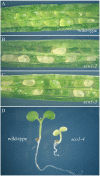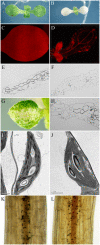Mutations in a plastid-localized elongation factor G alter early stages of plastid development in Arabidopsis thaliana
- PMID: 17629920
- PMCID: PMC2041950
- DOI: 10.1186/1471-2229-7-37
Mutations in a plastid-localized elongation factor G alter early stages of plastid development in Arabidopsis thaliana
Abstract
Background: Proper development of plastids in embryo and seedling tissues is critical for plant development. During germination, plastids develop to perform many critical functions that are necessary to establish the seedling for further growth. A growing body of work has demonstrated that components of the plastid transcription and translation machinery must be present and functional to establish the organelle upon germination.
Results: We have identified Arabidopsis thaliana mutants in a gene that encodes a plastid-targeted elongation factor G (SCO1) that is essential for plastid development during embryogenesis since two T-DNA insertion mutations in the coding sequence (sco1-2 and sco1-3) result in an embryo-lethal phenotype. In addition, a point mutation allele (sco1-1) and an allele with a T-DNA insertion in the promoter (sco1-4) of SCO1 display conditional seedling-lethal phenotypes. Seedlings of these alleles exhibit cotyledon and hypocotyl albinism due to improper chloroplast development, and normally die shortly after germination. However, when germinated on media supplemented with sucrose, the mutant plants can produce photosynthetically-active green leaves from the apical meristem.
Conclusion: The developmental stage-specific phenotype of the conditional-lethal sco1 alleles reveals differences in chloroplast formation during seedling germination compared to chloroplast differentiation in cells derived from the shoot apical meristem. Our identification of embryo-lethal mutant alleles in the Arabidopsis elongation factor G indicates that SCO1 is essential for plant growth, consistent with its predicted role in chloroplast protein translation.
Figures






Similar articles
-
Characterization of the snowy cotyledon 1 mutant of Arabidopsis thaliana: the impact of chloroplast elongation factor G on chloroplast development and plant vitality.Plant Mol Biol. 2006 Mar;60(4):507-18. doi: 10.1007/s11103-005-4921-0. Plant Mol Biol. 2006. PMID: 16525888
-
Characterization of the plastid-specific germination and seedling establishment transcriptional programme.J Exp Bot. 2012 Jan;63(2):925-39. doi: 10.1093/jxb/err322. Epub 2011 Nov 2. J Exp Bot. 2012. PMID: 22048039
-
The plastidic DEAD-box RNA helicase 22, HS3, is essential for plastid functions both in seed development and in seedling growth.Plant Cell Physiol. 2013 Sep;54(9):1431-40. doi: 10.1093/pcp/pct091. Epub 2013 Jun 25. Plant Cell Physiol. 2013. PMID: 23803517
-
Influence of plastids on light signalling and development.Philos Trans R Soc Lond B Biol Sci. 2014 Mar 3;369(1640):20130232. doi: 10.1098/rstb.2013.0232. Print 2014 Apr 19. Philos Trans R Soc Lond B Biol Sci. 2014. PMID: 24591718 Free PMC article. Review.
-
Biogenic signals from plastids and their role in chloroplast development.J Exp Bot. 2022 Nov 19;73(21):7105-7125. doi: 10.1093/jxb/erac344. J Exp Bot. 2022. PMID: 36002302 Review.
Cited by
-
Understanding chloroplast biogenesis using second-site suppressors of immutans and var2.Photosynth Res. 2013 Oct;116(2-3):437-53. doi: 10.1007/s11120-013-9855-9. Epub 2013 May 24. Photosynth Res. 2013. PMID: 23703455 Review.
-
Inducible knockdown of MONOGALACTOSYLDIACYLGLYCEROL SYNTHASE1 reveals roles of galactolipids in organelle differentiation in Arabidopsis cotyledons.Plant Physiol. 2014 Nov;166(3):1436-49. doi: 10.1104/pp.114.250050. Epub 2014 Sep 24. Plant Physiol. 2014. PMID: 25253888 Free PMC article.
-
Indispensable Roles of Plastids in Arabidopsis thaliana Embryogenesis.Curr Genomics. 2010 Aug;11(5):338-49. doi: 10.2174/138920210791616716. Curr Genomics. 2010. PMID: 21286311 Free PMC article.
-
Plastid encoded RNA polymerase activity and expression of photosynthesis genes required for embryo and seed development in Arabidopsis.Front Plant Sci. 2014 Aug 12;5:385. doi: 10.3389/fpls.2014.00385. eCollection 2014. Front Plant Sci. 2014. PMID: 25161659 Free PMC article.
-
Functional divergence of chloroplast Cpn60α subunits during Arabidopsis embryo development.PLoS Genet. 2017 Sep 29;13(9):e1007036. doi: 10.1371/journal.pgen.1007036. eCollection 2017 Sep. PLoS Genet. 2017. PMID: 28961247 Free PMC article.
References
-
- Mansfield SG, Briarty LG. Early embryogenesis in Arabidopsis thaliana. II. The developing embryo. Can J Bot. 1991;69:461–476.
-
- Eastmond P, Kolacna L, Rawsthorne S. Photosynthesis by developing embryos of oilseed rape (Brassica napus L) J Exp Bot. 1996;47:1763–1769. doi: 10.1093/jxb/47.11.1763. - DOI
-
- King SP, Badger MR, Furbank RT. CO2 refixation characteristics of developing canola seeds and silique wall. Aust J Plant Physiol. 1998;25:377–386.
Publication types
MeSH terms
Substances
LinkOut - more resources
Full Text Sources
Molecular Biology Databases

